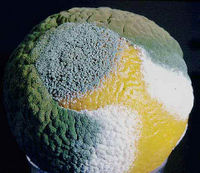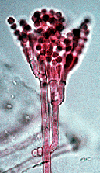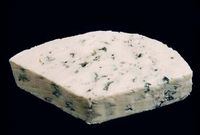Penicillium: Difference between revisions
No edit summary |
No edit summary |
||
| Line 4: | Line 4: | ||
|} | |} | ||
[[Image:penici3.jpg | [[Image:penici3.jpg|thumb|200px|right|''Penicillium italicum'' and ''Penicillium digitatum'' growing on an orange. [http://www.uoguelph.ca/%7Egbarron/MISCELLANEOUS/penicill.htm by George Barron]]] | ||
==Classification== | ==Classification== | ||
| Line 10: | Line 10: | ||
===Higher order taxa=== | ===Higher order taxa=== | ||
Eukaryota; Fungi/Metazoa group; Fungi; Ascomycota; Pezizomycotina; Eurotiomycetes; Eurotiales; Trichocomaceae; mitosporic Trichocomaceae | Eukaryota; Fungi/Metazoa group; Fungi; Ascomycota; Pezizomycotina; Eurotiomycetes; Eurotiales; Trichocomaceae; mitosporic Trichocomaceae | ||
===Species=== | ===Species=== | ||
''Penicillium notatum<br /> ''Penicillium chrysogenum''<br /><span class="main">''Penicillium roquefortii'' | ''Penicillium notatum<br /> ''Penicillium chrysogenum''<br /><span class="main">''Penicillium roquefortii'' | ||
==Description and Significance== | ==Description and Significance== | ||
| Line 28: | Line 28: | ||
==Cell Structure and Metabolism== | ==Cell Structure and Metabolism== | ||
[[Image:BlueCheese_md.jpg | [[Image:BlueCheese_md.jpg|thumb|200px|right|Bleu cheese made from <span class="main">''Penicillium roquefortii''</span>. [http://www.virtualmuseum.ca/Exhibitions/Mushroom/English/Lives/ The Fungus Among Us]]] | ||
With the exception of ''Penicillium marneffei'', which is thermally dimorphic, Penicillium are filamentous fungi. They have branched conidiospores. Conidia are round and unicellular. Glucans are common in the cell walls of Penicillium species. Penicillium species tend to have small hyphae. This makes protoplasmic movement difficult to detect. The small hyphae also lead to smaller peripheral growth zones. Penicillium spores have a hydrophobic surface. However, they are capable of being wetted; this is necessary for germination to occur. Penicillium are osmotolerant, meaning that although they grow better with high water levels, they are able to tolerate low water potential. | With the exception of ''Penicillium marneffei'', which is thermally dimorphic, Penicillium are filamentous fungi. They have branched conidiospores. Conidia are round and unicellular. Glucans are common in the cell walls of Penicillium species. Penicillium species tend to have small hyphae. This makes protoplasmic movement difficult to detect. The small hyphae also lead to smaller peripheral growth zones. Penicillium spores have a hydrophobic surface. However, they are capable of being wetted; this is necessary for germination to occur. Penicillium are osmotolerant, meaning that although they grow better with high water levels, they are able to tolerate low water potential. | ||
| Line 37: | Line 37: | ||
==Ecology== | ==Ecology== | ||
[[Image:p12.gif|frame|left|Penicillium mitospores (conidia). [http://tolweb.org/tree?group=Ascomycota&contgroup=Fungi#titlefigcaption Ascomycota: Sac Fungi by John W. Talyor, Joey Spatafora, and Mary Berbee]]] | |||
Pencillium fungi are versatile and opportunistic. They are post-harvest pathogens. Penicillium species are one of the most common causes of fungal spoilage in fruits and vegetables. ''Penicillium italicum'' and ''Penicillium digitatum'' are the most common attackers of citrus fruits, while ''Penicillium expansum'' is known to attack apples. ''P. digitatum '' works by producing ethylene to accelerate ripening. It the covers the fruit with green conidia, causing the fruit to shrivel and dry out. ''P. italicum ''causes slimy rot and produces blue-green conidia. These species like cooler temperatures, which explains why they are usually found on foods left too long in the refrigerator. Many species produce mycotoxins; for example, ''P. expansum ''produces one called patulin. Most of these species resemble each other in color characteristics, style of decay, and infection symptoms; they fall under a general category called blue mold. ''P. expansum'' is one of the most aggressive species. These fungi live a long time and are quite durable, even under adverse conditions. Sometimes, ''P. italicum'' and ''P. expansum'' will adhere to each other to create synnemata. Synnemata also occurs in Penicillum claviforme. Penicillium growth typically occurs as a result of wound infections in produce. The most common treatment is to use fungicide on harvested produce. Penicillium species attack more than just fruit. For example, ''Penicillium verrucosum'' grows on cereal products. | Pencillium fungi are versatile and opportunistic. They are post-harvest pathogens. Penicillium species are one of the most common causes of fungal spoilage in fruits and vegetables. ''Penicillium italicum'' and ''Penicillium digitatum'' are the most common attackers of citrus fruits, while ''Penicillium expansum'' is known to attack apples. ''P. digitatum '' works by producing ethylene to accelerate ripening. It the covers the fruit with green conidia, causing the fruit to shrivel and dry out. ''P. italicum ''causes slimy rot and produces blue-green conidia. These species like cooler temperatures, which explains why they are usually found on foods left too long in the refrigerator. Many species produce mycotoxins; for example, ''P. expansum ''produces one called patulin. Most of these species resemble each other in color characteristics, style of decay, and infection symptoms; they fall under a general category called blue mold. ''P. expansum'' is one of the most aggressive species. These fungi live a long time and are quite durable, even under adverse conditions. Sometimes, ''P. italicum'' and ''P. expansum'' will adhere to each other to create synnemata. Synnemata also occurs in Penicillum claviforme. Penicillium growth typically occurs as a result of wound infections in produce. The most common treatment is to use fungicide on harvested produce. Penicillium species attack more than just fruit. For example, ''Penicillium verrucosum'' grows on cereal products. | ||
| Line 47: | Line 49: | ||
One of the things Penicillium is most famous for is the drug penicillin. It was used to create the first antibiotic. The originial strain, ''Penicillium notatum'', was discovered in 1920 by Sir Alexander Fleming. However, it was replaced with ''Penicillium chrysogenum'', a more productive species, which is now the species used in manufacturing penicillin. | One of the things Penicillium is most famous for is the drug penicillin. It was used to create the first antibiotic. The originial strain, ''Penicillium notatum'', was discovered in 1920 by Sir Alexander Fleming. However, it was replaced with ''Penicillium chrysogenum'', a more productive species, which is now the species used in manufacturing penicillin. | ||
==References== | ==References== | ||
[http://www.ncbi.nlm.nih.gov/entrez/query.fcgi?cmd=Retrieve&db=pubmed&dopt=Abstract&list_uids=15881598&query_hl=30 Balkan B, Ertan F. | [http://www.ncbi.nlm.nih.gov/entrez/query.fcgi?cmd=Retrieve&db=pubmed&dopt=Abstract&list_uids=15881598&query_hl=30 Balkan B, Ertan F. "Production and properties of alpha-amylase from Penicillium chrysogenum and its application in starch hydrolysis." <span title="Preparative biochemistry & biotechnology.">Prep Biochem Biotechnol.</span> 2005;35(2):169-78.] | ||
[http://www.ncbi.nlm.nih.gov/entrez/query.fcgi?cmd=Retrieve&db=pubmed&dopt=Abstract&list_uids=15895263&query_hl=30 Bancerz R, Ginalska G, Fiedurek J, Gromada A. | [http://www.ncbi.nlm.nih.gov/entrez/query.fcgi?cmd=Retrieve&db=pubmed&dopt=Abstract&list_uids=15895263&query_hl=30 Bancerz R, Ginalska G, Fiedurek J, Gromada A. "Cultivation conditions and properties of extracellular crude lipase from the psychrotrophic fungus Penicillium chrysogenum 9'" <span title="Journal of industrial microbiology & biotechnology.">J Ind Microbiol Biotechnol.</span> 2005 May 14; [Epub ahead of print].] | ||
[http://www.uoguelph.ca/%7Egbarron/index.htm Barron, George. Website on Fungi. ] | [http://www.uoguelph.ca/%7Egbarron/index.htm Barron, George. Website on Fungi. ] | ||
| Line 64: | Line 64: | ||
[http://www.virtualmuseum.ca/Exhibitions/Mushroom/English/Lives/ The Fungus Among Us] | [http://www.virtualmuseum.ca/Exhibitions/Mushroom/English/Lives/ The Fungus Among Us] | ||
[http://www.caf.wvu.edu/kearneysville/disease_month/bluemold0199.html Janisiewicz, Wojciech. | [http://www.caf.wvu.edu/kearneysville/disease_month/bluemold0199.html Janisiewicz, Wojciech. "Blue Mold'', Penicillium spp.''"] | ||
[http://www.anselm.edu/homepage/jpitocch/genbios/surveybi04.html Pitocchelli, Jay. "Survey of representatives of the major Kingdoms." ] | [http://www.anselm.edu/homepage/jpitocch/genbios/surveybi04.html Pitocchelli, Jay. "Survey of representatives of the major Kingdoms."] | ||
[http://www.scielo.br/scielo.php?pid=S1415-47572002000400020&script=sci_arttext&tlng=en Ribon, Andréa O. B., Marisa V. Queiroz and Elza F. de Araújo. "Structural organization of polygalacturonase-encoding genes from ''Penicillium griseoroseum''." Genetics and Molecular Biology, vol. 25, no. 4: 2002.] | |||
[http://www.ncbi.nlm.nih.gov/entrez/query.fcgi?cmd=Retrieve&db=pubmed&dopt=Abstract&list_uids=15809010&query_hl=30 Rodriguez-Saiz M, Diez B, Barredo JL. | [http://www.ncbi.nlm.nih.gov/entrez/query.fcgi?cmd=Retrieve&db=pubmed&dopt=Abstract&list_uids=15809010&query_hl=30 Rodriguez-Saiz M, Diez B, Barredo JL. "Why did the Fleming strain fail in penicillin industry?" <span title="Fungal genetics and biology : FG & B.">Fungal Genet Biol.</span> 2005 May;42(5):464-70.] | ||
[http://tolweb.org/tree?group=Ascomycota&contgroup=Fungi#titlefigcaption Taylor, John W., Joey Spatafora, and Mary Berbee. ''Ascomycota: Sac Fungi''. The Tree of Life Web Project.] | [http://tolweb.org/tree?group=Ascomycota&contgroup=Fungi#titlefigcaption Taylor, John W., Joey Spatafora, and Mary Berbee. ''Ascomycota: Sac Fungi''. The Tree of Life Web Project.] | ||
[http://www.ncbi.nlm.nih.gov/entrez/query.fcgi?cmd=Retrieve&db=pubmed&dopt=Abstract&list_uids=15839403&query_hl=30 Tournas VH. | [http://www.ncbi.nlm.nih.gov/entrez/query.fcgi?cmd=Retrieve&db=pubmed&dopt=Abstract&list_uids=15839403&query_hl=30 Tournas VH. "Spoilage of vegetable crops by bacteria and fungi and related health hazards." <span title="Critical reviews in microbiology.">Crit Rev Microbiol.</span> 2005;31(1):33-44.] | ||
Revision as of 19:00, 15 June 2006
|
NCBI: |

Classification
Higher order taxa
Eukaryota; Fungi/Metazoa group; Fungi; Ascomycota; Pezizomycotina; Eurotiomycetes; Eurotiales; Trichocomaceae; mitosporic Trichocomaceae
Species
Penicillium notatum
Penicillium chrysogenum
Penicillium roquefortii
Description and Significance
Penicillium are comparable to Aspergillus. The genus Penicillium falls into the order Eurotiales. In this order, organisms produce asci within cleistothecia. Penicillium is often reffered to as Deuteromycetes, or Fungi imperfecti. The name Penicillium comes from the word "brush"; this refers to the appearance of spores in Penicillium.
One species, Penicillium chrysogenum 9', is classified as a psychrotrophic microorganism. Bancerz et. al. (2005) found that this species was one of the best lipase producers among other fungi they studied in the arctic tundra. Penicillium chrysogenum has high enzymatic activity and has the ability to produce alpha-amylase.
Genome Structure
Most fungi contain secondary metabolites. These are often used to create antibiotics such as penicillin. Certain components of fungal genetic strucutre that create these secondary metabolites are common across not just species, but across orders. The genetic structures that make up these secondary metabolites are often very complex. Carlile et. al. (2001) cite an example in which of 11 amino acids in cyclosporin, only two were found in protiens. It is believed that genes encoding some of the enzymes are found in clusters on a single chromosome. Evidence for this has been found in Penicillium chrysogenum, among other organisms. The location of these genes suggests that the individual chromosome may play a role in expression of these genes. Ribon et. al. (2001) found that endopolygalacturonase-coding genes exist as single copies on the fungus genome in Penicillium griseoroseum. They also found that P. griseoroseum has a similar hybridization pattern to P. expansum, P. italicum, and P. purpurogenum. This suggests that the genes in these species have simlar global organization in their particular genome segment.
Cell Structure and Metabolism
With the exception of Penicillium marneffei, which is thermally dimorphic, Penicillium are filamentous fungi. They have branched conidiospores. Conidia are round and unicellular. Glucans are common in the cell walls of Penicillium species. Penicillium species tend to have small hyphae. This makes protoplasmic movement difficult to detect. The small hyphae also lead to smaller peripheral growth zones. Penicillium spores have a hydrophobic surface. However, they are capable of being wetted; this is necessary for germination to occur. Penicillium are osmotolerant, meaning that although they grow better with high water levels, they are able to tolerate low water potential.
Penicillium species are heterotrophic. The pathogenic species feed off of the fruit they destroy.
Penicillium produces asexually, and are unable to sporulate when submerged. However, they begin reproduction easily when hyphae emerge into a gas phase. No species has the exact same method of reproduction. Each is classified based on the way it reproduces. For example, in some species, conidia are borne on phialidies, which group out of the conidiophore. In others the conidiophore bears metullae, where phialidies are borne. Still in others the conidiophore may branch out before bearing metullae. Branching may or may not be symmetrical, depending on species. Sporulation is not stimulated by changes in oxygen, carbon dioxide, or water loss. Instead, it is associated with change in physical environment at the hyphal surface. There is no specific method for ascospore dispersal.
Ecology

Pencillium fungi are versatile and opportunistic. They are post-harvest pathogens. Penicillium species are one of the most common causes of fungal spoilage in fruits and vegetables. Penicillium italicum and Penicillium digitatum are the most common attackers of citrus fruits, while Penicillium expansum is known to attack apples. P. digitatum works by producing ethylene to accelerate ripening. It the covers the fruit with green conidia, causing the fruit to shrivel and dry out. P. italicum causes slimy rot and produces blue-green conidia. These species like cooler temperatures, which explains why they are usually found on foods left too long in the refrigerator. Many species produce mycotoxins; for example, P. expansum produces one called patulin. Most of these species resemble each other in color characteristics, style of decay, and infection symptoms; they fall under a general category called blue mold. P. expansum is one of the most aggressive species. These fungi live a long time and are quite durable, even under adverse conditions. Sometimes, P. italicum and P. expansum will adhere to each other to create synnemata. Synnemata also occurs in Penicillum claviforme. Penicillium growth typically occurs as a result of wound infections in produce. The most common treatment is to use fungicide on harvested produce. Penicillium species attack more than just fruit. For example, Penicillium verrucosum grows on cereal products.
One species, Penicillium marneffei, is rare to most of the world. It is endemic to Southeast Asia and infects bamboo rats. It can be spread to humans, especially immunosuppressed individuals.
However, Penicillium is not merely a harmful fungus. It also has many useful species. For example, Penicillium roquefortii is used to make bleu cheese. The color of the cheese comes from the spores (conidia) of the fungus. The spores are injected into the cheese curd during fermentation. Penicillium camambertii is another species used to produce cheese.
Some Penicillium species actually help prevent fungal decay as opposed to producing it. Penicillium chrysogenum produces glucose oxidase, which is used as a preservative in fruit juices.
One of the things Penicillium is most famous for is the drug penicillin. It was used to create the first antibiotic. The originial strain, Penicillium notatum, was discovered in 1920 by Sir Alexander Fleming. However, it was replaced with Penicillium chrysogenum, a more productive species, which is now the species used in manufacturing penicillin.
References
Barron, George. Website on Fungi.
Doctor Fungus: Penicillium species.
Janisiewicz, Wojciech. "Blue Mold, Penicillium spp."
Pitocchelli, Jay. "Survey of representatives of the major Kingdoms."

